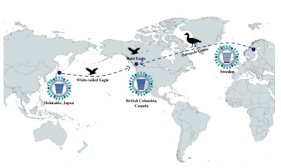
#18,040
Despite nearly 30 years of dealing with H5N1, we have an unfortunate habit of underestimating what the HPAI H5Nx virus is capable of. In the early 2000s, the virus was believed to be restricted to Southeast Asia, since the nearly everybody `knew' that sick migratory birds don't fly.
This peculiar bit of self-delusion persisted until December of 2014 when HPAI H5Nx crossed the relatively narrow Bering Straits and began spreading across Canada and the United States, sparking the biggest avian epizootic (to that time) in North American history.Even after the virus winged its way to Europe, the Middle East, and Africa (following the 2005 Qinghai Lake event ) many experts still doubted the ability of the virus to spread efficiently via migratory birds (see 2014's Bird Flu Spread: The Flyway Or The Highway?).
Luckily, HPAI wasn't sustained in North American birds (see PNAS: The Enigma Of Disappearing HPAI H5 In North American Migratory Waterfowl) and the outbreak did not resume the following fall.
PLoS One: North Atlantic Flyways Provide Opportunities For Spread Of Avian Influenza Viruses
H5Nx: Why North America Must Remain Alert
Iceland Warns On Bird Flu
In late 2021, the inevitable happened, and HPAI H5 arrived in Eastern Canada and Western Canada via two different routes; across the Pacific and the Atlantic (Multiple Introductions of H5 HPAI Viruses into Canada Via both East Asia-Australasia/Pacific & Atlantic Flyways).
Unlike older versions of HPAI H5, this reinvented avian flu was able to persist in a wide array of avian (and a few mammalian) hosts. Meaning it no longer requires re-introduction of the virus every year.While we've seen no evidence of west-to-east spread of North American HPAI viruses to Europe, we have seen evidence that some North American LPAI viruses have crossed over into Asia.
According to the Icelandic Institute of Natural History, birds from both Canada and Europe regularly visit Iceland, making an exchange of avian viruses plausible (see below).
A total of 75 bird species regularly nest in Iceland, and a number of others occasionally choose to breed here, although they have been slow to establish themselves permanently. Some Arctic birds spend the winter in Iceland but nest at more northerly latitudes. Iceland is an extremely important stopover for geese and waders migrating between breeding grounds in Greenland and Canada and wintering grounds in Europe.
In late 2022, in Iceland as Stepping Stone for Spread of Highly Pathogenic Avian Influenza Virus between Europe and North America, we looked at an EID Journal Synopsis on the role Iceland, and migratory birds, played in introducing HPAI H5Nx to the North America.
All of which brings us to a new study, by many of the same authors, that identifies Iceland as a likely, but underestimated, hub for the intercontinental spread of HPAI viruses.
I've only included a few excerpts, so follow the link to read the full report.
Iceland: an underestimated hub for the spread of high-pathogenicity avian influenza viruses in the North Atlantic
Ann Kathrin Ahrens1, Stefán Ragnar Jónsson2, Vilhjálmur Svansson2, Brigitte Brugger3, Martin Beer1, Timm C. Harder1 and Anne Pohlmann1
Published: 02 May 2024 https://doi.org/10.1099/jgv.0.001985
High-pathogenicity avian influenza viruses (HPAIVs) of the goose/Guangdong lineage are enzootically circulating in wild bird populations worldwide. This increases the risk of entry into poultry production and spill-over to mammalian species, including humans. Better understanding of the ecological and epizootiological networks of these viruses is essential to optimize mitigation measures.Based on full genome sequences of 26 HPAIV samples from Iceland, which were collected between spring and autumn 2022, as well as 1 sample from the 2023 summer period, we show that 3 different genotypes of HPAIV H5N1 clade 2.3.4.4b were circulating within the wild bird population in Iceland in 2022.Furthermore, in 2023 we observed a novel introduction of HPAIV H5N5 of the same clade to Iceland. The data support the role of Iceland as an utmost northwestern distribution area in Europe that might act also as a potential bridging point for intercontinental spread of HPAIV across the North Atlantic.
In conclusion, our data confirm that Iceland is involved in the circulation of clade 2.3.4.4b HPAI H5N1 viruses both as a sink for viruses from continental European and as a source for North America. It is therefore reasonable to assume that Iceland could act as a gateway for avian influenza in the transatlantic transmission pathway.
However, to date there is no evidence of west-to-east transmission.
Nevertheless, Iceland remains an important sampling area for the detection of novel avian influenza incursions. Iceland also remains a focal point for ongoing monitoring with regard to the potential impact of the HPAI epidemic in seabirds on biodiversity and the protection of endangered species.
While HPAI H5 has yet to crack the code on how to infect and spread efficiently in humans, it continues to exceed most other expectations.
Our focus today is understandably on the recent spillover into American cattle, but we need to remember that the virus is following hundreds of divergent evolutionary pathways around the globe, most of which are occurring outside of our view.
Most will result in failure, but the virus only has to get `lucky' once.
Which is why we need to cast a wide net, be prepared for surprises, and the strong likelihood that some will come from out of left field.

